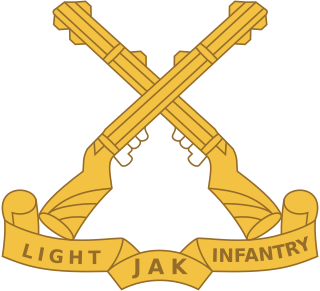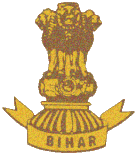
The Jammu and Kashmir Rifles is an infantry regiment of the Indian Army. Its origins lay in the Jammu and Kashmir State Forces of the princely state of Jammu and Kashmir. After the accession of the state to the Indian Union in October 1947, the State Forces came under the command of the Indian Army. They remained in the original form until 1956 when Jammu and Kashmir Constituent Assembly effectively ratified the state's accession to India. Then the State Forces became the Jammu and Kashmir Regiment of the Indian Army. In 1963, the designation was changed to Jammu and Kashmir Rifles. After the conversion, the Ladakh Scouts came under the aegis of the Regiment, where it remained until raised as a separate Regiment in 2002.

The Parachute Regiment is an airborne and special forces regiment of the Indian Army. It was raised in 1945 as part of the British Indian Army but was disbanded after World War II and was re-raised in 1952 as part of the Indian Army. Currently it consists of fifteen Special Forces, two Territorial Army and one Rashtriya Rifles battalions.

The Kumaon Regiment is one of the oldest infantry regiments of the Indian Army. The regiment traces its origins to the 18th century and has fought in every major campaign of the British Indian Army and the Indian Army, including the two world wars, and is one of the highest decorated regiments of the Indian Army.

The Madras Regiment is the oldest infantry regiment of the Indian Army, originating in the 1750s as a unit of the British East India Company. The regiment took part in numerous campaigns with the British Indian Army and the post-independence Indian Army.

The Jammu and Kashmir Light Infantry is an infantry regiment of the Indian Army. The regimental center is in Srinagar's Airport Complex at Awantipora with a winter setup near Jammu. Its regimental insignia consists of a pair of crossed rifles. The regiment mostly consists of volunteers from the state of Jammu & Kashmir and ethnic groups from the state. The Jammu and Kashmir Light Infantry is considered to be one of the most decorated regiment of the Indian army having won 1 Param Veer Chakra and 3 Ashok Chakra. Naib Subedar Chuni Lal of the 8th battalion Jammu and Kashmir Light Infantry is one of the most decorated personnel of the Indian Army.

Operation Meghdoot was the codename for the Indian Army operation to take full control of the Siachen Glacier in Ladakh). Executed on the morning of 13 April 1984 in the highest battlefield in the world, Meghdoot was the first military offensive of its kind. This operation preempted Pakistan's Operation Ababeel; and was a success. Resulting in Indian forces gaining control of the Siachen Glacier in its entirety.
The Sikh Light Infantry is a light infantry regiment of the Indian Army. The regiment is the successor unit to the 23rd, 32nd and 34th Royal Sikh Pioneers of the British Indian Army. The regiment recruits from the Sikh community of Himachal Pradesh, Punjab and Haryana states of India.

The Garhwal Rifles, formerly known as the Royal Garhwal Rifles, are an infantry regiment of the Indian Army. It was originally raised in 1887 as the 39th (Garhwal) Regiment of the Bengal Army. It then became part of the British Indian Army, and after the Independence of India, it was incorporated into the Indian Army.

The Assam Regiment is an infantry regiment of the Indian Army. The regiment consists of 25 battalions: 15 regular battalions, 3 Rashtriya Rifles battalions, 5 Territorial Army battalions & 2 Arunachal Scouts battalions. It recruits exclusively from all the eight Northeastern states of India.
Colonel Chewang Rinchen MVC & Bar, SM was a highly decorated officer in the Indian Army from the Union territory of Ladakh. He was the youngest ever recipient of the Maha Vir Chakra, the second highest Indian gallantry decoration, for his role in the defence of Ladakh in the First Kashmir War. He received the Maha Vir Chakra for a second time after Indo-Pakistani War of 1971, for his role in the conquest of the Turtuk and Tyakshi, in what came to be known as the Battle of Turtuk. He was one of only six Indian service personnel to have the Maha Vir Chakra twice. He was awarded a Sena Medal for gallantry in the 1962 India-China War. and Mention in dispatches for gallantry in the Indo-Pakistani War of 1965

The 8th Gorkha Rifles is a Gorkha regiment of the Indian Army. It was raised in 1824 as part of the British East India Company and later transferred to the British Indian Army after the Indian Rebellion of 1857. The regiment served in World War I and World War II, before being one of the six Gurkha regiments transferred to the Indian Army after independence in 1947. Since then it has served in a number of conflicts including the Sino-Indian War of 1962 and the Indo-Pakistan wars of 1965 and 1971. Today the 8th Gorkha Rifles is one of the most celebrated regiments of the Indian Army, having received numerous citations for bravery in the field of battle, and even producing one of the two field marshals of India, Field Marshal Sam Manekshaw, of the Indian Army.

The Naga Regiment is an infantry regiment of the Indian Army. It is among the youngest regiments of the Indian Army - the first battalion was raised in Ranikhet, Kumaon in 1970. The regiment recruits mainly from Nagaland, in northeast India.

The Bihar Regiment is an Indian Army infantry regiment. It traces its origins back to the British Indian Army. The Bihar Regiment was formed in 1941 by regularising the 11th (Territorial) Battalion, the 19th Hyderabad Regiment, and raising new battalions. The Bihar Regimental Centre (BRC) is located at Danapur Cantonment, Patna, the second oldest cantonment of India. INS Vikramaditya, the Indian Navy's largest ship and one of its two aircraft carriers is affiliated to the Bihar Regiment, Indian Army's highly decorated and battle-hardened unit.

Naib Subedar Chuni Lal AC, VrC, SM was an Indian Army soldier of The Jammu and Kashmir Light Infantry. He was born in Bhaderwah, and basically from Gandhari Paddar and lived in Bhara village with parents Shanker Dass and Shakuntala Devi in Doda district of Jammu. Decorated with Vir Chakra and Sena Medal (Gallantry), JC-593527, Lal was killed in action on 24 June 2007 in a militant flush-out operation in Kashmir's Kupwara sector. These militants, all of whom were also shot dead, were trying to cross the Line of Control (LoC) and enter Indian territory. The success of this militant flush-out operation, which claimed his life, earned him the highest peacetime military decoration awarded for valor, courageous action or self-sacrifice away from the battlefield, the Ashok Chakra. He is the highest decorated soldier of the Indian Army of all time, honored with Sena Medal, Vir Chakra and Ashok Chakra.
Colonel Sonam Wangchuk, MVC is an Indian Army veteran, who served with the Assam Regiment and the Ladakh Scouts. He was awarded the Maha Vir Chakra, India's second highest award for gallantry in the face of the enemy, during his successful operation in the Kargil War. Due to his exemplary feet as a Major during Kargil War, he is known as the Lion of Ladakh in the Indian Army.

Lieutenant General Yogesh Kumar Joshi, PVSM, UYSM, AVSM, VrC, SM, ADC is a retired General Officer of the Indian Army. He was the General Officer Commanding-in-Chief Northern Command, assuming office from Lt Gen Ranbir Singh on 1 February 2020. He last served as the Chief of staff of the Northern Command, assuming the office from Lt Gen SK Sharma. Previously, he was the commander of Leh based Fire & Fury Corps. As Army Commander he is credited with spearheading the Indian response to PLA's attempt to alter the status quo on Line of Actual Control (LAC) by use of force. He is the only war decorated Army Commander who has to his credit successes against both Indian adversaries China and Pakistan.
Yaldor Sub Sector was the scene of some of the major infiltration by Pakistani Northern Light Infantry battalions and some of the major battles of Kargil War were fought here.

Colonel Thakur Prithi Chand, MVC, was an officer of the Indian Army. He is known for his significant role in stalling Pakistani advances in Ladakh during the Indo-Pakistan War of 1947-48. For his role in this war, Thakur Prithi Chand is regarded among the 'Saviours of Ladakh', alongside Kushal Chand, Bhim Chand, and Chewang Rinchen.
75 Medium Regiment is part of the Regiment of Artillery of the Indian Army.
13 Medium Regiment (Chushul and Gadra City) is part of the Regiment of Artillery of the Indian Army, and has the distinction of having two post-independence honour titles.


















